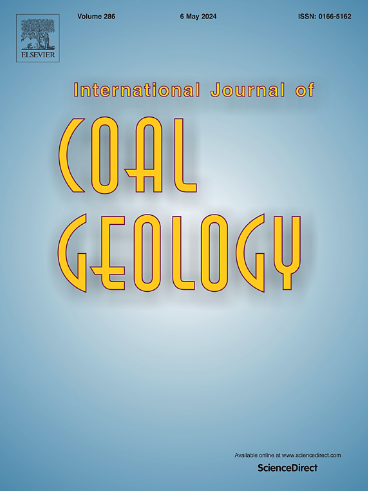上白垩统第二白斑页岩热成熟过程中孔隙结构演化——来自人工和自然成熟样品的启示
IF 5.7
2区 工程技术
Q2 ENERGY & FUELS
引用次数: 0
摘要
采用上白垩统第二白斑页岩自然成熟样品(Ro 0.46 ~ 1.26%)和半开放体系(200 ~ 450℃)人工成熟样品,研究了海相页岩热成熟过程中孔隙结构的演化。分析技术,包括岩石热解,FIB-FESEM和氮吸附,揭示了孔隙体积(PV)和比表面积(SSA)的关键趋势。未成熟样品表现出较高的PV和SSA,在生油早期(Ro ~ 0.98%或350°C)由于压实和石油填充而降低。在350 ~ 400℃范围内,PV和SSA在Ro为0.98% ~ 1.26%之间显著升高,且在较高温度下仍保持升高。与自然成熟的样品相比,人工成熟的样品显示出更高的PV和SSA,这反映了实验室条件下没有压实和胶结过程。由于排烃动力学和地质因素,自然演化样品表现出更大的非均质性,在生烃过程中形成复杂的孔隙网络。有机质(OM)组成在孔隙演化中起着关键作用,以陆源输入的II型干酪根为主。无定形有机质(AOM)和固体沥青是主要的有机质组分,脂质组、陆源镜质组和惰质组也有贡献。粘土矿物为主,黄铁矿树状体为溶蚀次生孔隙。扫描电镜成像发现了5种孔隙类型,其中om储集孔隙主要形成于沥青中,而不是干酪根中。中孔(2 ~ 50 nm)为主要孔隙类型,微孔(<;2 nm)可以忽略不计。荧光显微镜和热解实验证实,在高温下,运移沥青的成熟度随深度增加而增加,并伴有明显的颗粒内孔隙形成。与自然系统相比,人工成熟研究强调了更快的生烃和孔隙发育,但无法复制长期的埋藏效应。在人工体系中,PV与排油量呈正相关,沥青含量与PV和SSA呈负相关。先进的成像技术和综合的自然和实验模型对于进一步了解页岩储层的孔隙演化、连通性和生烃机制至关重要。该研究强调了天然和人工成熟过程中有机质组成、矿物学和热过程在形成页岩孔隙度方面的相互作用。本文章由计算机程序翻译,如有差异,请以英文原文为准。
Evolution of pore structure in the Upper Cretaceous Second White Speckled Shale during thermal maturation: Insights from artificial and naturally matured samples
The evolution of pore structures in marine shale during thermal maturation was investigated using naturally matured samples (Ro 0.46–1.26 %) from the Upper Cretaceous Second White Speckled Shale and artificially matured samples in a semi-open system (200–450 °C). Analytical techniques, including Rock-Eval pyrolysis, FIB-FESEM, and nitrogen adsorption, revealed key trends in pore volume (PV) and specific surface area (SSA). Immature samples exhibited high PV and SSA, which decreased during early oil generation (Ro ∼0.98 % or 350 °C) due to compaction and oil infill. PV and SSA rose significantly between Ro 0.98 % and 1.26 % (350–400 °C), driven by mesopore development, and remained elevated at higher temperatures. Artificially matured samples showed higher PV and SSA compared to naturally evolved samples, reflecting the absence of compaction and cementation processes in laboratory conditions. Naturally evolved samples demonstrated greater heterogeneity due to expulsion dynamics and geological factors, developing complex pore networks during hydrocarbon generation. Organic matter (OM) composition, dominated by Type II kerogen with terrestrial inputs, played a critical role in pore evolution. Amorphous organic matter (AOM) and solid bitumen were the primary OM components, with liptinite macerals and terrigenous vitrinite and inertinite also contributing. Clay minerals dominated the rock matrix, while pyrite framboids contributed dissolution-induced secondary porosity. SEM imaging identified five pore types, with OM-hosted pores forming predominantly in bitumen rather than kerogen. Mesopores (2–50 nm) were the dominant pore type, while micropores (< 2 nm) were negligible. Fluorescence microscopy and pyrolysis experiments confirmed increasing maturity with depth, accompanied by significant intraparticle pore formation in migrated bitumen at higher temperatures. Artificial maturation studies highlight faster hydrocarbon generation and pore development compared to natural systems but fail to replicate long-term burial effects. PV correlated positively with expelled oil in artificial systems, while bitumen content negatively correlated with PV and SSA in both systems. Advanced imaging techniques and integrated natural and experimental models are essential to further understanding pore evolution, connectivity, and hydrocarbon generation mechanisms in shale reservoirs. This study emphasizes the interplay between OM composition, mineralogy, and thermal processes in shaping shale porosity during natural and artificial maturation.
求助全文
通过发布文献求助,成功后即可免费获取论文全文。
去求助
来源期刊

International Journal of Coal Geology
工程技术-地球科学综合
CiteScore
11.00
自引率
14.30%
发文量
145
审稿时长
38 days
期刊介绍:
The International Journal of Coal Geology deals with fundamental and applied aspects of the geology and petrology of coal, oil/gas source rocks and shale gas resources. The journal aims to advance the exploration, exploitation and utilization of these resources, and to stimulate environmental awareness as well as advancement of engineering for effective resource management.
 求助内容:
求助内容: 应助结果提醒方式:
应助结果提醒方式:


